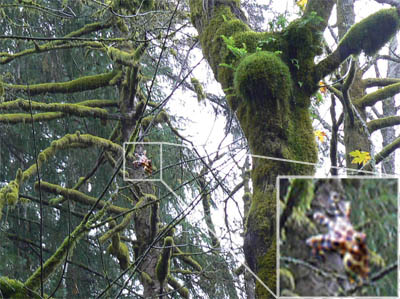


Besides allowing them to see their prey and environment, it helps them in inter-octopus relations. Tree octopuses have eyesight comparable to humans. Reaching out with one of her eight arms, each covered in sensitive suckers, a tree octopus might grab a branch to pull herself along in a form of locomotion called tentaculation or she might be preparing to strike at an insect or small vertebrate, such as a frog or rodent, or steal an egg from a bird's nest or she might even be examining some object that caught her fancy, instinctively desiring to manipulate it with her dexterous limbs (really deserving the title "sensory organs" more than mere "limbs",) in order to better know it. (Some evolutionary theorists suppose that "arboreal adaptation" is what laid the groundwork in primates for the evolution of the human mind.) The challenges and richness of this environment (and the intimate way in which it interacts with it,) may account for the tree octopus's advanced behavioral development.
THE PACIFIC NORTHWEST TREE OCTOPUS SKIN
Because of the moistness of the rainforests and specialized skin adaptations, they are able to keep from becoming desiccated for prolonged periods of time, but given the chance they would prefer resting in pooled water.Īn intelligent and inquisitive being (it has the largest brain-to-body ratio for any mollusk), the tree octopus explores its arboreal world by both touch and sight.Īdaptations its ancestors originally evolved in the three dimensional environment of the sea have been put to good use in the spatially complex maze of the coniferous Olympic rainforests. Unlike most other cephalopods, tree octopuses are amphibious, spending only their early life and the period of their mating season in their ancestral aquatic environment. These solitary cephalopods reach an average size (measured from arm-tip to mantle-tip,) of 30-33 cm. Their habitat lies on the Eastern side of the Olympic mountain range, adjacent to Hood Canal. The Pacific Northwest tree octopus (Octopus paxarbolis) can be found in the temperate rainforests of the Olympic Peninsula on the west coast of North America. It was purported to be able to live both on land and in water, and is said to live in the Olympic National Forest and nearby rivers, spawning in water where eggs are laid. The Pacific Northwest Tree Octopus fictitious endangered species of cephalopod, was given the Latin name "Octopus paxarbolis" (which means, roughly, "Pacific tree octopus").


 0 kommentar(er)
0 kommentar(er)
